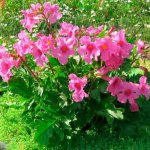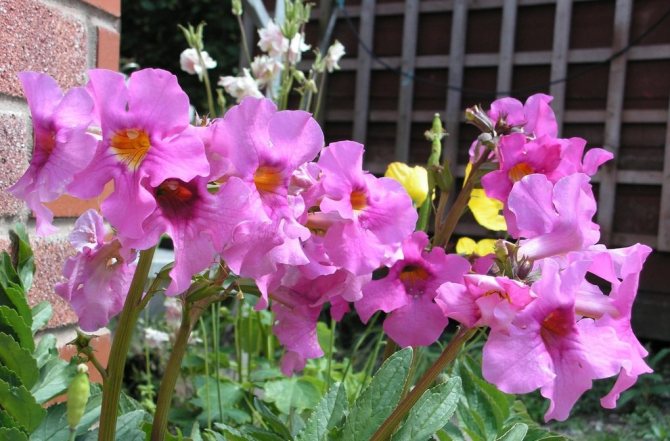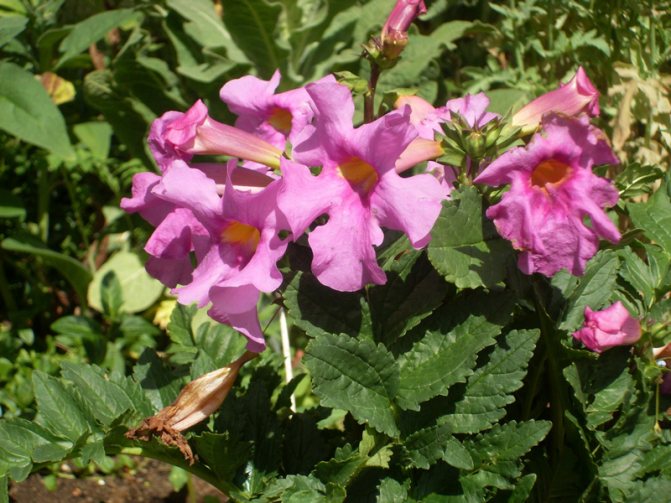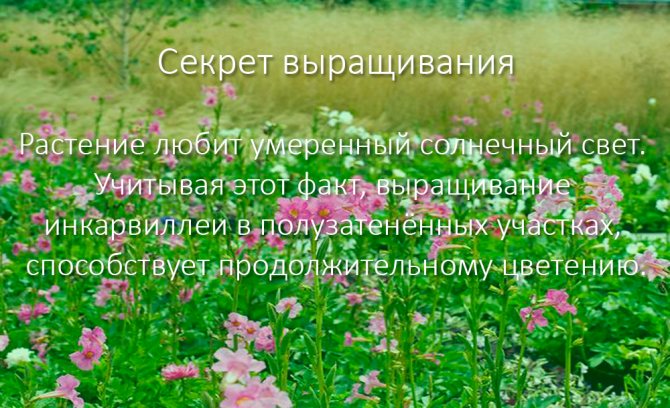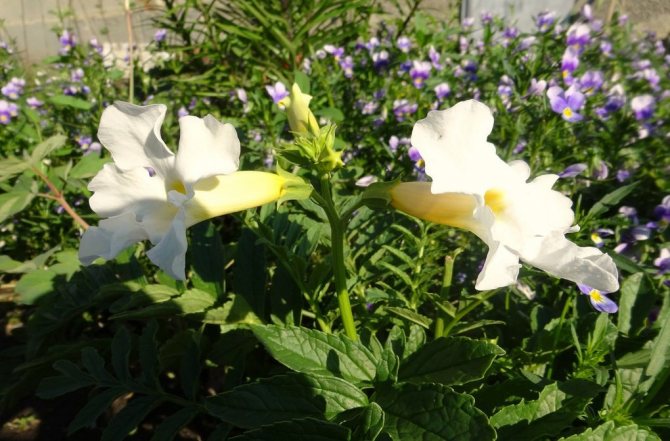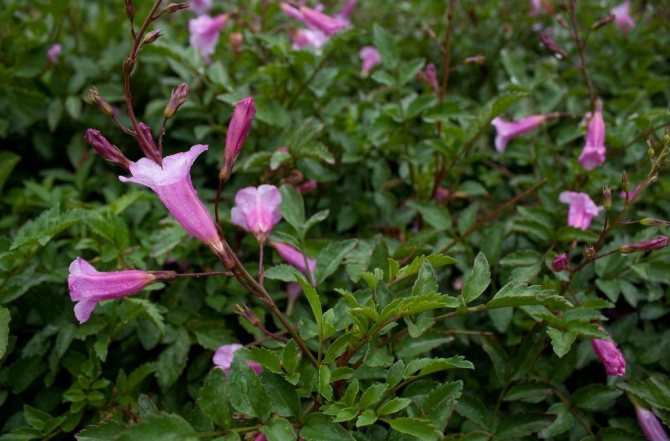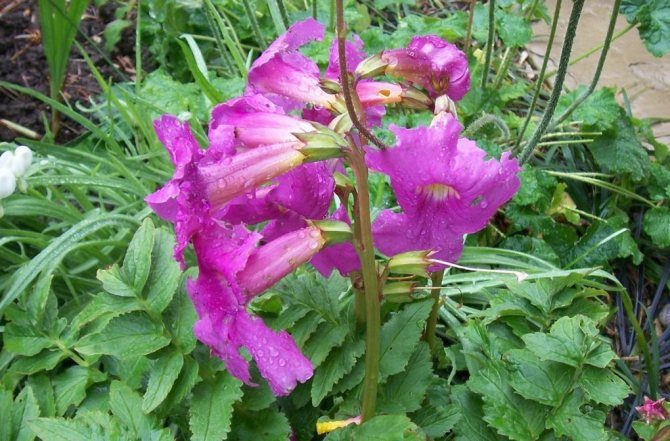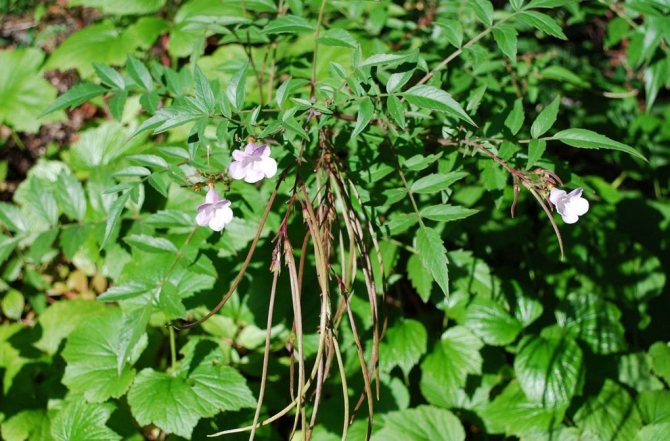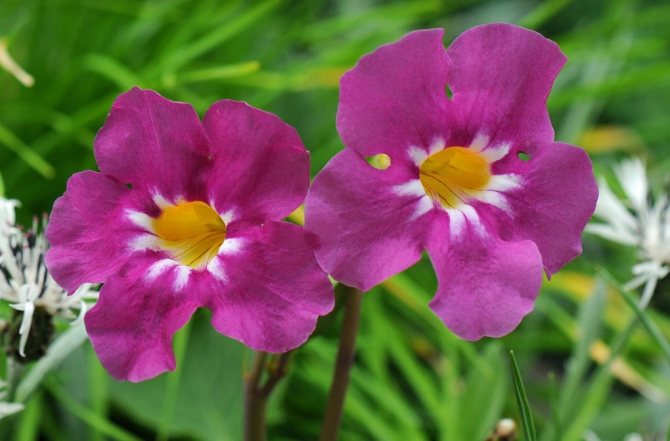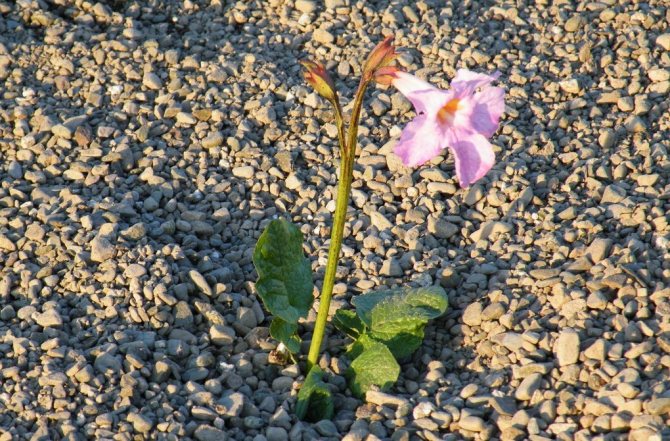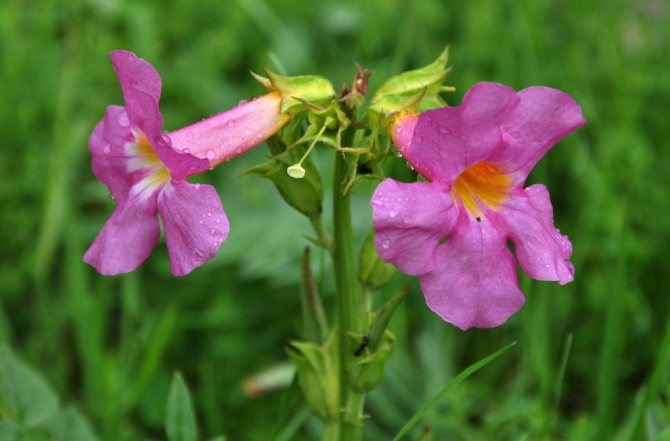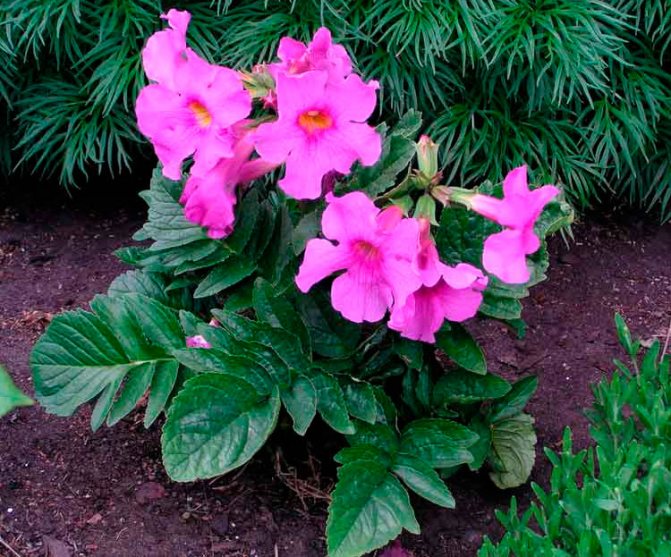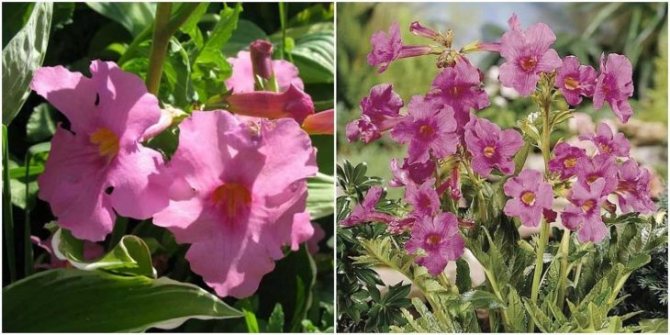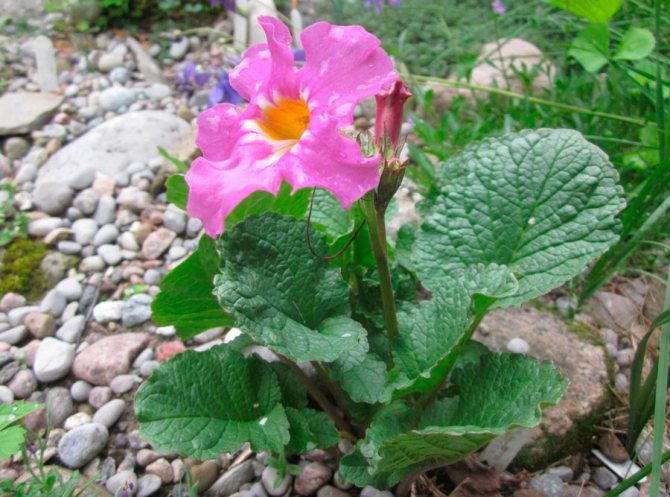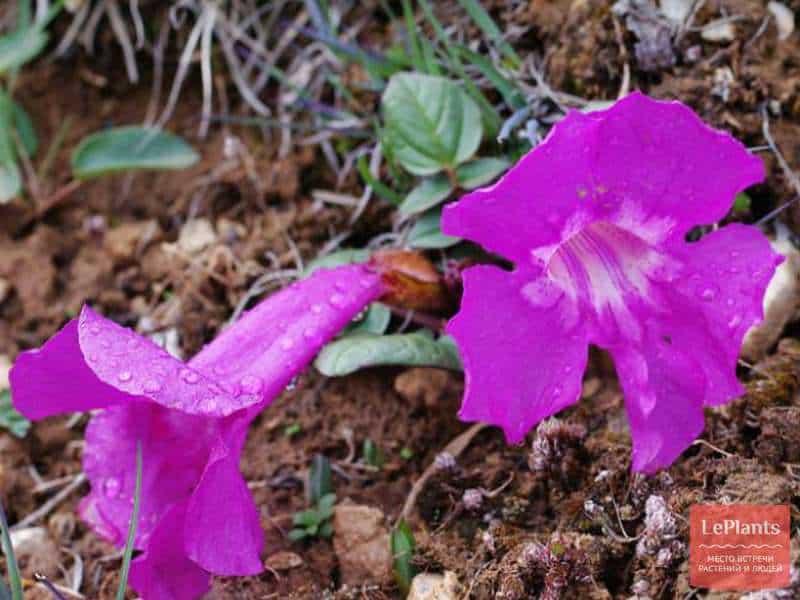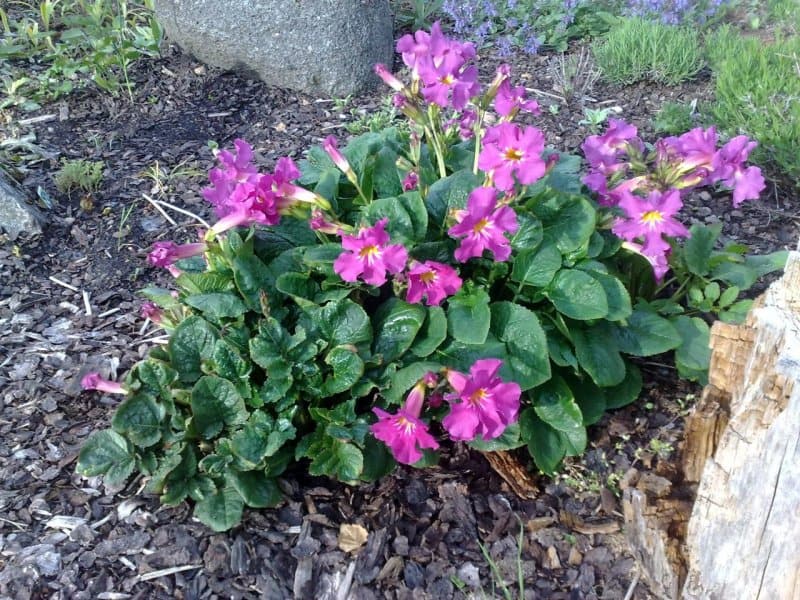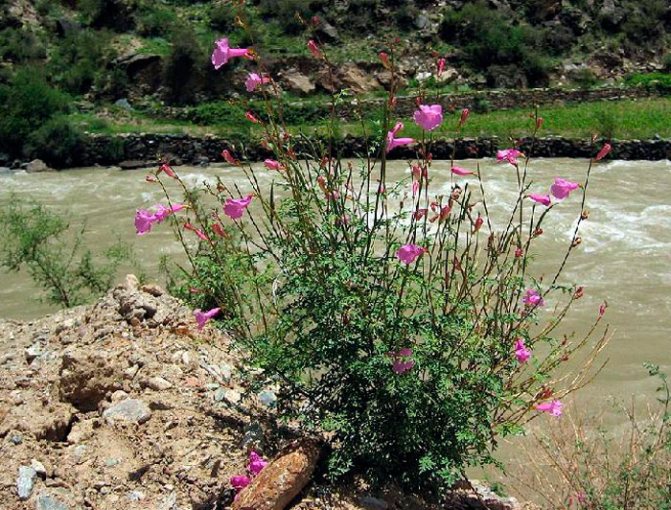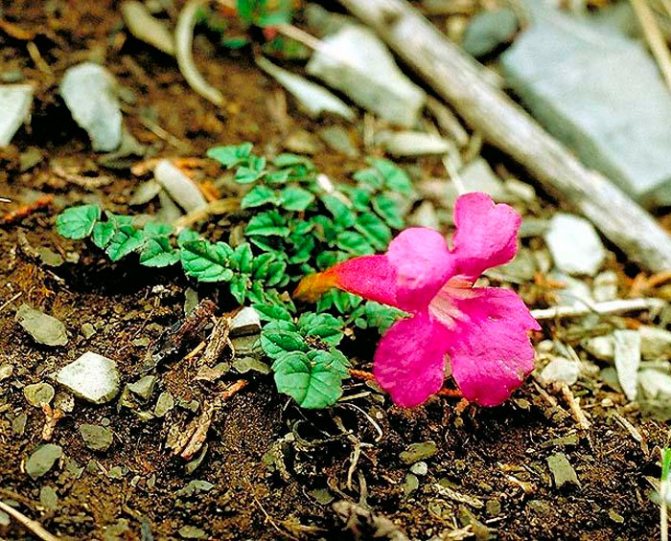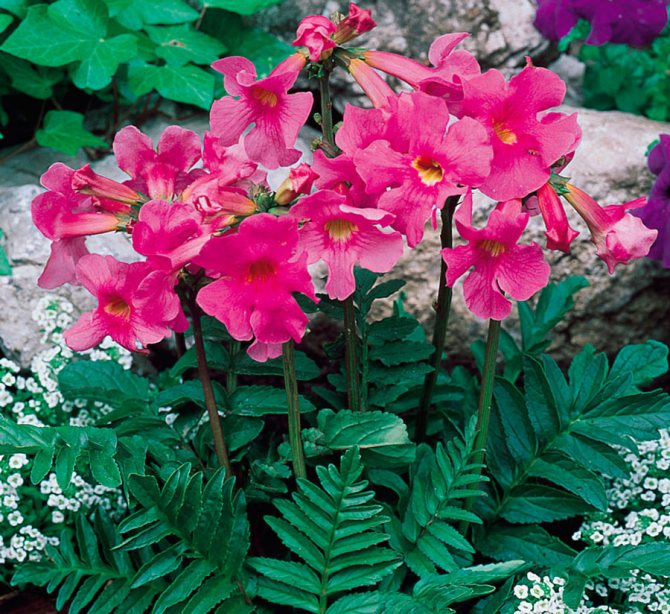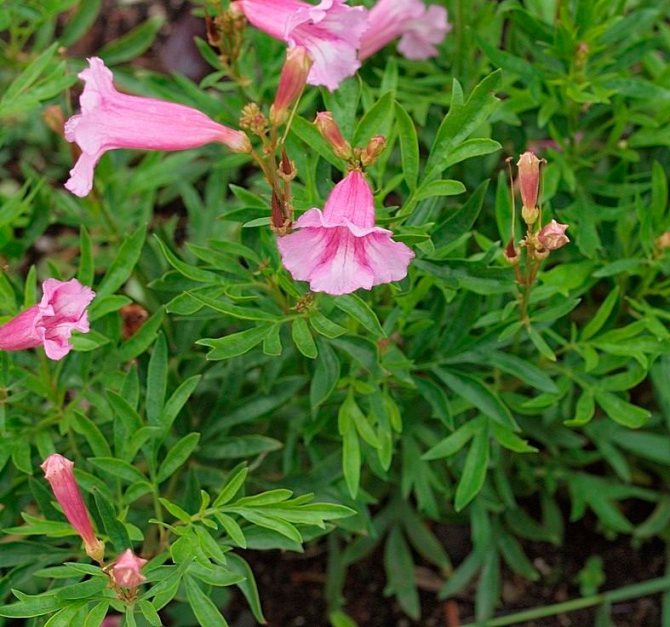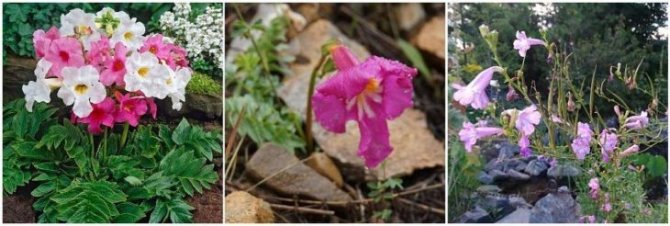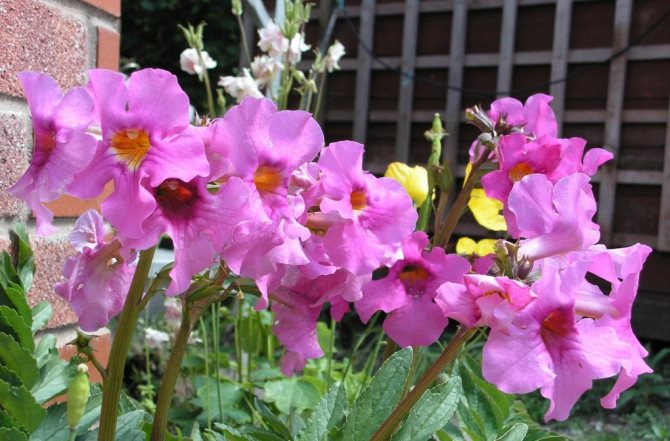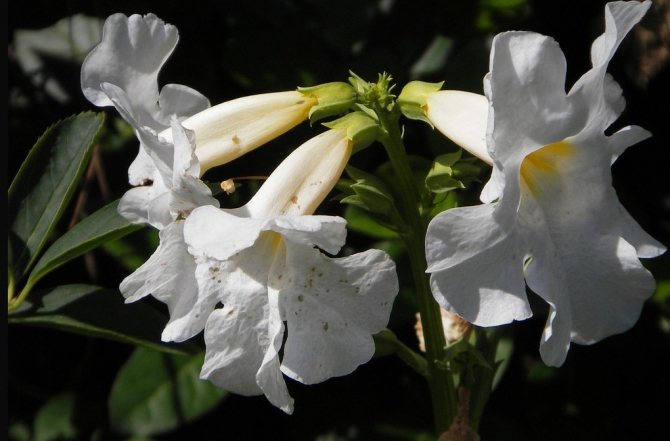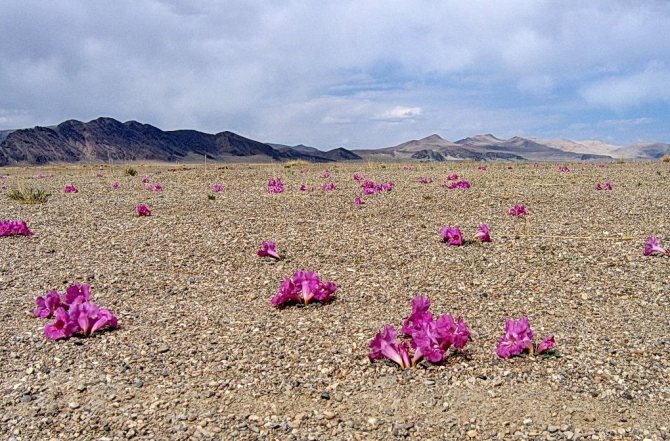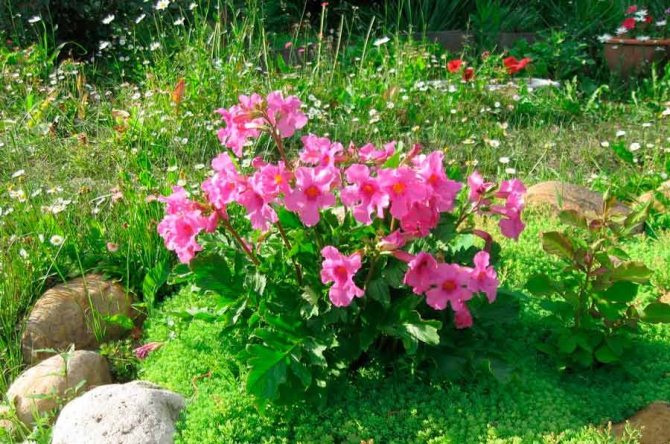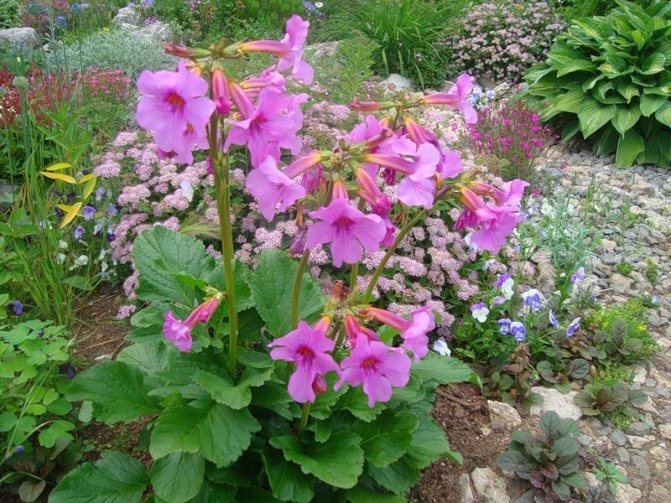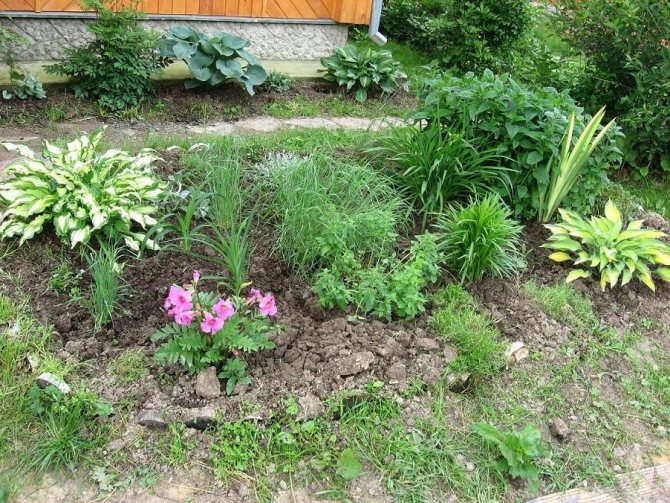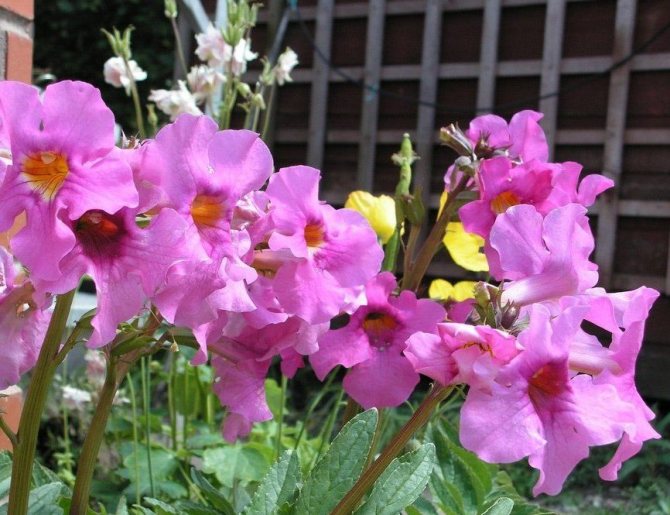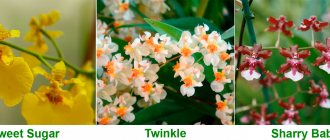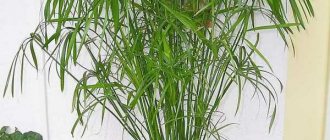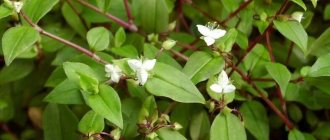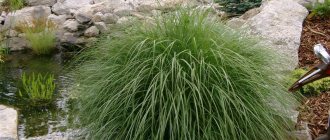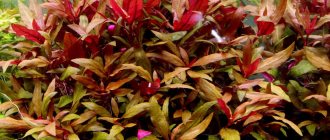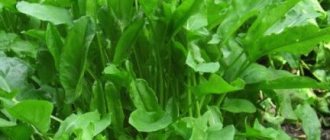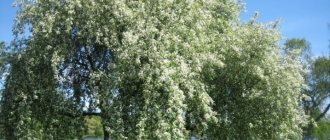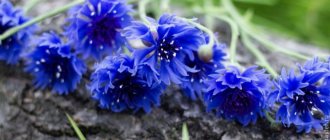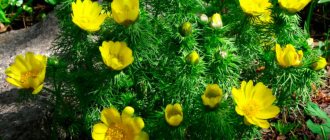The herbaceous plant Incarvillea is a member of the Bignonieva family. According to The Plant List, this genus unites 17 species. The scientific name for this plant was given in honor of Pierre Nicolas d'Incarville in China, who collected a large collection of plants, which also contains representatives of this genus. In the wild, this herb can be found in Central and East Asia and the Himalayas. As a rule, cultivated varieties of this genus are called garden gloxinia.
Description of incarvillea
According to its botanical description, Incarvillea is an annual, biennial or perennial herbaceous rhizome plant with a height of 30 to 100 cm, with a tuberous or woody root system and straight branchy shoots. The leaves are large, dark green, pinnately spaced, cordate or oval, with a silvery or purple tint, collected in a basal rosette, alternately located. The leaf plates are wrinkled, velvety to the touch.
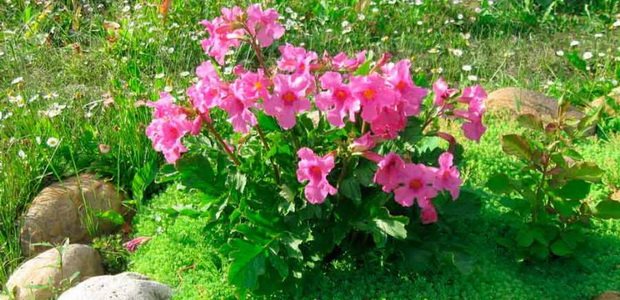
In the upper part of the peduncles, racemose or paniculate inflorescences are formed. The flowers are tubular, with a wide corolla, consisting of 5 petals, about 6 cm in diameter. The edges of the petals are bent outward. The shades of Incarvillea can be different: white, yellow, pink, purple and red.
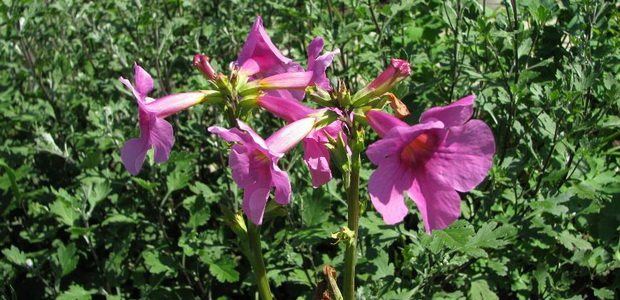

Flowering lasts 20 to 45 days, from May to June or June to July, depending on the species.
The fruit is a bipartite polygonal capsule containing winged, pubescent, flattened gray-brown seeds.
The seeds for sowing are harvested in August after the fruit has ripened.
Using
Bright inflorescences of various heights are suitable for decorating areas near garden paths and hedges, as well as on rocky areas. It goes well with violets, irises and iberis. You can create a whole flower bed from different types of Incarvillea by choosing specimens with different colors of petals and structure of leaves. The bright flowers on long stems can be used for bouquets, but they are not durable.
Long before the appearance of man on earth, it was decorated with various flowers. Among this lush splendor of plants, of course, grew a modest beauty - Incarvillea. In accordance with popular beliefs, flowers are the symbolic hair of the Earth, which decorates it in an original way. Depending on the weather conditions, they replace each other in order to inspire and delight a person. Spring flowers are replaced by summer ones, and autumn and frost-resistant winter specimens appear behind them. So for a whole year we live surrounded by silent gentle creatures.
Most of all people pay attention to garden flowers. Among the many options, I would like to highlight one modest beauty.
Incarville got its name in honor of the famous French missionary Pierre de Incarville. He was an ardent fan of green plants, so he looked for the most bizarre options. When the botanist was in China, the pearl of his collection was an unusual perennial flower. Pierre carefully studied this plant, observing it in natural conditions. What is he, this humble garden handsome man?
Incarvillea species
Incarvillea delavayi.
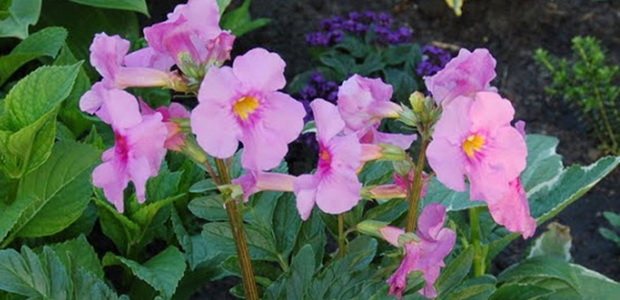

According to its characteristics, the Delaway Incarvillea reaches a height of 60-80 cm, and its numerous opposite dark green leaves have a feathery shape. They attach to a long, sturdy stem and resemble the leaves of some fern species in appearance. On a straight arrow there are dark pink or purple-red, large (up to 7 cm in diameter) flowers in the form of phonographs. On one arrow there are six or seven of them;
Iincarvillea compact, or dense (Incarvillea compacta).
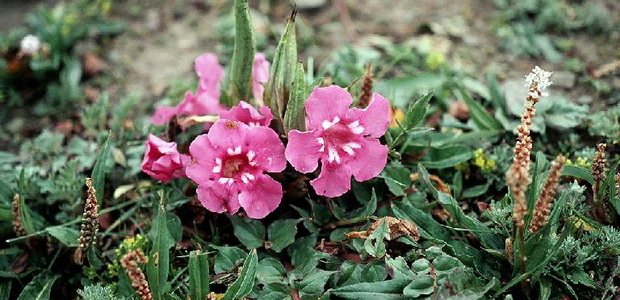

Variety, which is a medium-sized bush with a height of 30 to 60 cm. Leaves are oval or heart-shaped, feathery, dark green, dense. The flowers are lilac-pink, large, up to 6 cm in diameter. Varieties with very large flowers, up to 8 cm in diameter, have been bred. Bloom from May to June.
Incarvillea compact large-flowered (Incarvillea compacta var. Grandijlora).
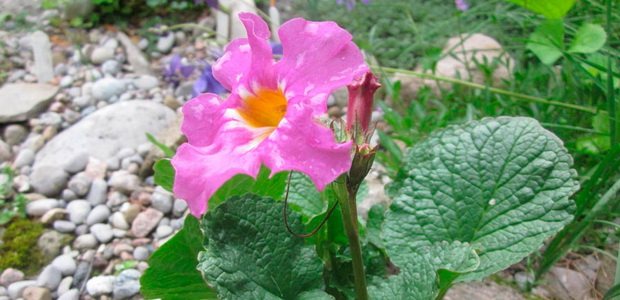

On long arrows, which reach a height of 30 to 80 cm, there are very beautiful pink-red flowers with a bright yellow throat. The leaves are larger and not as numerous as those of the species described above. The plant can reach a height of 80 cm;
Chinese Incarvillea (Incarvillea sinensis).
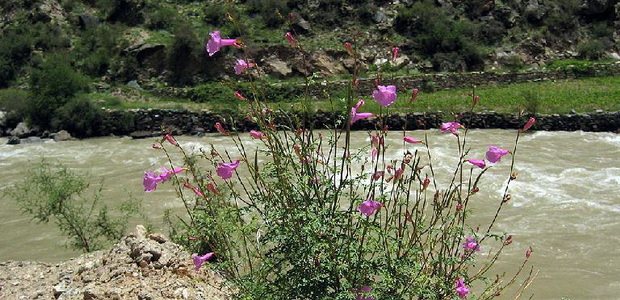

A low-growing form, the height of which does not exceed 30 cm. The leaves are feathery, bright green, dense, with a bluish tint. The flowers are yellow-creamy. The flowering of this species lasts a long time due to the regular release of new shoots.
Incarvillea mairei.
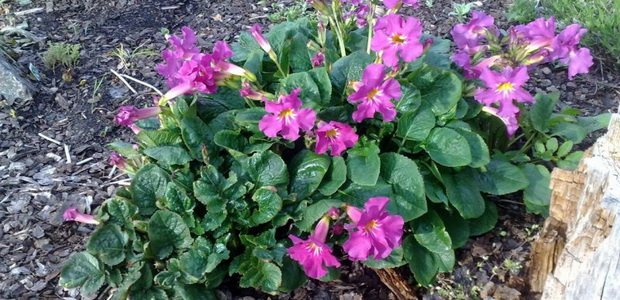

This species is a lush bush with lyre-shaped leaves collected in a basal rosette. The flowers are large, up to 8 cm in diameter, red-pink, with white spots inside the corolla. This plant has increased frost resistance. Bloom from June to July.
Olga's Incarvillea (Incarvillea olgae).
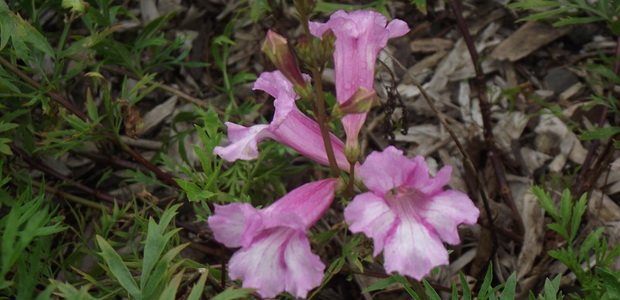

Densely branching shrub up to 50 cm high with bare stems in the upper part. The leaves are openwork, pinnately dissected, dark green, opposite. Inflorescences are loose panicles up to 25 cm long. The flowers are red-pink, their diameter is 2 cm. The species has an average frost resistance, requires shelter for the winter.
You can get a complete picture of what the types of Incarvillea flower look like by looking at the following photo selection:
Acquaintance with popular varieties
The exotic flower that came to us from China is of different types. Gardeners have about 14 options. The most popular ones are:
- Delaway;
- Mayra;
- Olga;
- Chinese;
- Dense.
A short description of each of them will help you get to know them.
Incarvillea Delaway
Having considered the photos of Delaway's Incarvillea, it is not difficult to fall in love with this delicate, humble flower. The plant was first discovered in southwestern China. The flower grows up to 120 cm in height. The leaves are collected in the form of a rosette near the rhizome. Their length is 30 cm.
Incarvillea buds are colored pink. The middle of the cup is yellow. Diameter - about 6 cm. Flowers are collected in several pieces in pretty carpal inflorescences. The buds bloom in June and bloom until mid-summer.
Planting and leaving Incarvillea Delaway includes the following operations:
- Sowing seeds. The plant can be sown in early spring in pots, and when the ground warms up - in open ground. The first shoots appear within a week. Incarville will not bloom in the first year.
- Division of the rhizome. This type of flower planting is practiced in early spring or late autumn. The rhizome dug out of the ground is cut into pieces, and then dug in with a small amount of soil.
- Cuttings. In the middle of summer, cuttings of the Delaway Incarvillea are cut, along with a small part of the shoot. They are placed in a container with water until the roots appear. Finished seedlings are planted in the ground.
A rooted plant requires moderate watering. It is advisable to cover the flower for the winter. Decorative form of Dilaweya with white color of buds - Incarvillea Snowtop.
Mayra variety
The flower grows up to 30 cm. The leaves are slightly dissected. The outer part of the buds is colored deep pink, the inner part is yellow with small white spots. It blooms in early summer. Not afraid of cold weather.
Incarvillea Olga
This variety grows up to half a meter. Shoots are strong, slightly branched from above. Leaves are dissected, feathery.Incarvillea of white color requires special attention, Its buds are collected in a panicle and are located at the top of the shoots. Flowering begins in mid-summer and lasts a month and a half.
Incarvillea Chinese
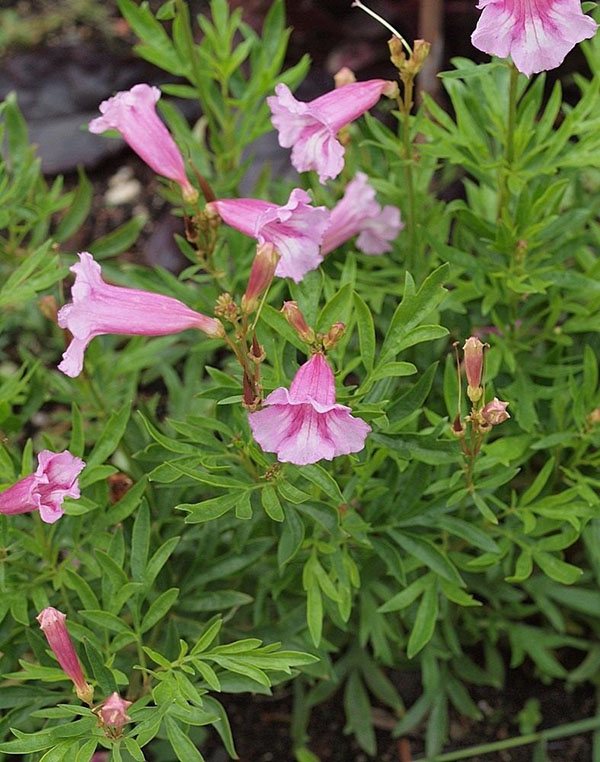

Some types of Incarvillea Chinese have creamy yellow or pinkish inflorescences and feathery leaves. The flower grows up to 30 cm. It blooms 2.5 months after planting.
Incarvillea Dense
A dwarf variety that grows up to 30 cm in height. Shoots of a smooth character, slightly drooping. Leaves are oval, with feathery roots. Blooms in June in large white or pink buds with a yellow center. The variety is frost-resistant, therefore it hibernates without shelter.
To choose the best option, you should take into account the local climate, the type of soil and the flowering time of the plant.
When you get up close and personal with different plants, it's easy to imagine your garden in all its glory. Incarvillea - a modest garden beauty can be the perfect decoration for a summer cottage.
Growing and caring for Incarvillea will not cause much trouble even for novice amateur flower growers, if the plant is provided with the necessary growing conditions. This bright beauty will delight you with its flowers from the beginning of May to the end of summer, but with short breaks. The variety of colors that nature has endowed our beauty with makes the flower bed of this flower very bright and colorful, which attracts attention.
Breeding features of Incarvillea
An exotic flower does not belong to the category of whimsical, but nevertheless, Incarvillea has its own characteristics of growing and care in the open field, which the gardener must take into account so that the bush is lush and abundant flowering.
Location. Before planting a plant, you need to choose the right place for it. It is light-requiring, tolerates light partial shade. Direct sunlight is detrimental to the flower, so shading should be created in open areas.
When growing Incarvillea, one should also remember that the roots are sensitive to excess moisture, for this reason it is better to plant this crop in rocky areas or in rock gardens.
The soil. Prefers nutritious, permeable soils with a neutral reaction. Fertile sandy loam soil is suitable for breeding Incarvillea. At the bottom of the planting pit, it is necessary to lay a drainage layer of expanded clay, sand, vermiculite, gravel, charcoal, broken clay brick or foam.
If the soil is acidic, then lime or dolomite flour will need to be added before planting the Incarvillea.
Watering. Watering should be regular, but moderate. An excess of moisture must not be allowed to avoid rotting of the root system. At the same time, the earthen lump should not dry out.
Top dressing. Carrying out the care of Incarvillea, fertilizing must be applied to the soil, for example, during transplantation and during the period of active growth, mineral fertilizers or organic matter are used. Mullein infusion is also suitable for this. It is important to respect the dosage. An excess of fertilizers negatively affects the winter hardiness of this crop.
Wintering. In central Russia it winters with varying success. In the process of growing Incarvillea and caring for it at the end of autumn, they are preparing for the cold before the onset of frost. The above-ground part of the plant is cut off, the roots are covered with a 10-centimeter layer of mulch, for example, peat, sawdust, needles. It is recommended to cover young individuals with spruce branches, this will protect them from prolonged autumn rains. With the arrival of spring, the shelter is removed so as not to provoke root decay.
You can dig out the rhizomes for the winter and store them in a cool, dark place.
Pests and diseases. The main pests are mealybugs, thrips, aphids, spider mites. Insecticides are effective in pest control.
With improper planting and care of the Incarvillea, for example, with excessive watering, the plant may begin to turn brown and the leaves may fall off. Yellowing of the leaves is the first sign of insufficient fertilization in the soil.
For the prevention of diseases, you need to try to follow the rules for caring for this crop and take into account its features when growing.
Mr. Dachnik warns: pests and diseases of Incarvillea
During the cultivation of Incarvillea, it can be attacked by such pests and diseases:
| Problem | Manifestation | Elimination |
| Rotting root system. | Withering and death of the plant. | They are treated with solutions of the fungicides Fundazol or Skora. Correct the irrigation regime, reducing the frequency of water application. |
| Spider mite. | Deformation of flowers and stems. White thin web. | Sprayed with Aktara and Aktellik. |
| Mealybug. | Withering leaves. An accumulation of white small insects. | They are treated with Actellik and Aktara acaricidal agents. |
With the timely disposal of these insects and diseases, the plant will delight with its healthy and blooming appearance.
Planting Incarvillea seeds in the ground
This culture is propagated by seeds, leaf cuttings, some species - by dividing the bush.
The seeds can be obtained on their own in the fall after the completion of flowering and ripening of the fruit.
With the seed propagation method, you can sow seeds directly into open ground. Work on growing Incarvillea from seeds should be carried out in mid-spring when warm weather is established and frost has disappeared. When sowing, it is worth considering that the seeds of the culture are quite large, so the distance between them should be at least 8 cm, then the seedlings will not have to be thinned out. The seeds are buried in the soil to a depth of 1 - 2 cm.The distance between the rows should be 15 cm.
Before planting, a ridge for seedlings is prepared in advance: it is dug up, sand and organic matter are added (compost or humus at the rate of 1 bucket per 1 square meter). After that, the ridges are not touched for several days so that the land can settle before sowing. After 5 - 7 days, furrows are made in the ridges, seeds are embedded in them and the crops are closed, carefully leveling the soil surface.
After planting the Incarvillea in open ground, the crops are cared for: they are slightly moistened, avoiding excess moisture, sprinkled with a layer of mulch no more than 1 cm thick.This will protect the crops from drying out and the formation of a hard crust on the surface of the ridge. After the emergence of seedlings, the ridges are weeded, the plants are rowed, if necessary, leaving a distance of 8 - 10 cm between them. The grown bushes are planted in a permanent place at a distance of 30 - 40 cm from each other.
Planting seeds in open ground allows you to get strong, healthy, winter-hardy plants. Flowering can be observed 2 - 3 years after planting.
You can see how the work of planting Incarvillea and caring for crops is being carried out in the photos shown below:
Reproduction
Garden gloxinia readily propagates by seeds, cuttings and dividing the bush require some skill, therefore they are suitable for more experienced gardeners. Moreover, by seed reproduction, you can create your own varieties with a unique color.
Seeds for future planting are harvested in advance, slightly unripe, in order to prevent their loss and self-seeding. After drying, they are stored in an airtight bag until early March. Before sowing, cold stratification is carried out for 2-3 weeks. Sow in a large shallow box on a fertile neutral substrate, which is pre-moistened. The seeds are deepened by 5-10 mm and carefully crushed with earth.
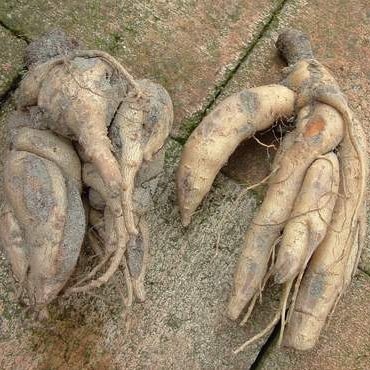

Not very friendly shoots appear by the end of the first week after sowing, if the temperature in the room is +18 .. + 20 ° С. With a decrease of only 5 degrees, the seeds will sprout a week later.With the appearance of two true leaves, the plant dives into separate pots. In early July, the matured seedlings are sent to the garden to a permanent place. The distance between them should be at least 30 cm. In warm regions, crops can be sown directly into open ground. They do this from the end of April to June.
For vegetative propagation in June, a stem with a small root area is separated from the main plant. To make the root system better formed, the petiole is placed in a stimulating solution (root or heteroauxin). The shoot is dripped in a pot and covered with a jar to avoid drying out the soil. After 15-20 days, the first independent roots appear. But this year, all the forces of the plant are directed to the development of the tuber. A beautiful leaf rosette and flowers are formed from the second year.
Growing Incarvillea seedlings from seed
Some gardeners prefer to grow Incarvillea seedlings from seed, considering this method of propagation to be more reliable.
Sowing seeds for seedlings is carried out in early spring. For this, the seeds are placed in small pots filled with a mixture of garden soil, sand and peat. You can purchase a ready-made potting soil mixture for flower seedlings in the store, but then it is recommended to treat it with a hot solution of saturated pink potassium permanganate.
Before sowing, the seeds are stratified, placed in a freezer for 1 month. After stratification, they are embedded in moist soil to a depth of 0.5 cm. Then the crops are watered and removed to a well-lit room. The first shoots appear in 7 to 10 days.
After the seedlings grow up to 5-7 cm, they are dived in separate pots. As a substrate, you can use a soil mixture consisting of two parts of turf, two parts of leafy soil and one part of sand. A good drainage from expanded clay or broken tiles is placed on the bottom of the pot. For diving, the soil is moistened so as not to damage the fragile roots of the seedlings during transplantation. Roots that are too long are pinched for better branching. The dived seedlings are watered and removed for 2 days in a dark place.
Incarvillea flower seedlings are planted in a permanent place with further care in July, at a distance of 10-15 cm from each other. Plants bloom the next year.
Care rules
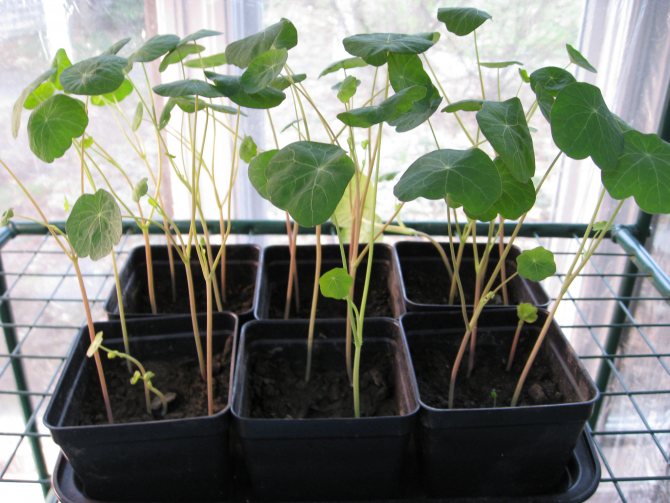

Shrub division is best done in autumn or early spring. If the landing is carried out in the autumn, then it is important to plan it before the onset of cold weather. Experts recommend starting the division of shrubs in September.
In the temperate climatic zone, the culture does not grow in one place for more than three years. It is important to take this into account in order to prepare the material for planting in advance. It can sprout well if stored for several years.
All varieties of this plant are prone to moderate humidity. Like indoor ornamental flowers, they have a negative attitude towards large amounts of water. As a result, this can lead to rotting and death of the culture. The gardener should try to water only when the soil dries. It is forbidden to leave petrified soil, as this can lead to the death of the flower. All moisturizing procedures should be carried out in the morning or in the evening, otherwise the sun's rays will simply burn the culture.
When a flower is grown by seedlings in the first year after planting, several leaves appear on it. Experts forbid digging up a flower bed with such a plant, it is best to leave it for next year.
Propagation of incarvillea by cuttings and dividing the bush
Novice gardeners prefer to propagate Incarvillea by cuttings, since this method is the simplest.
For reproduction, a large perennial plant is chosen, a large, intact dense leaf with a part of the stem is carefully cut from the rosette of leaves with a sharp knife. The cuttings are placed in a solution for several hours, activating the formation of roots.Then it is planted in a small pot with light nutritious soil and covered with foil or glass. After 2 - 3 weeks, the root system should form on the cuttings. The rosette of leaves will form only in the second year after planting.
In March or September, you can propagate the culture by dividing the bush. To do this, they choose a well-grown bush, dig it up and divide it into parts so that each delenka has a growing point for new shoots.
The plots are buried in the planting holes so that the root collar is 3 - 5 cm above the soil surface.
Planting should be carried out in warm weather at a temperature of 18 - 20 degrees, otherwise the plants may not take root.
After planting, care is taken, especially in the first weeks, by watering the bushes, removing weeds and not forgetting to loosen the soil around the young plants.
Incarvillea, post-flowering care and wintering
Most Incarvillea varieties need winter cover. Their root system does not tolerate sudden temperature fluctuations, as well as cold, snowless winters. If the flower is grown as a perennial crop, mulch should be prepared and covered with Incarvillea. Peat is mixed with humus and flooring is made over the tubers with a height of about 7 cm.
It is undesirable to cover the bushes with a large amount of fallen leaves. Under such a flooring, the tubers can vanish and die. It is better to cover young bushes for the winter with glass jars or plastic bottles. This will more reliably protect the flowers from cold and thaw. In spring, the mulch is removed immediately so that the roots receive a sufficient supply of oxygen.
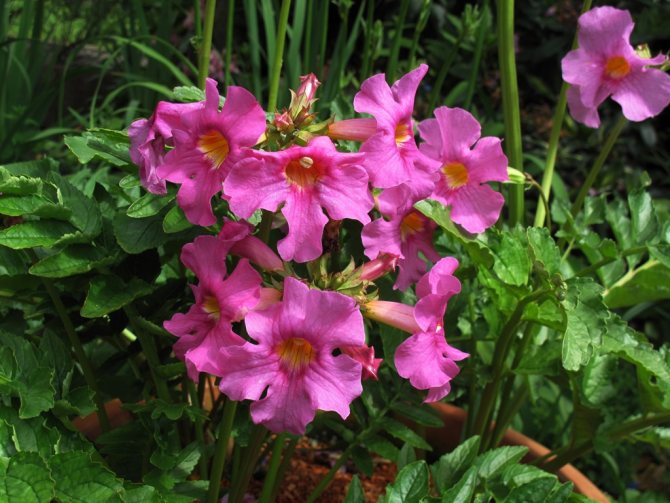

Secrets of growing an oriental beauty
To grow Incarvillea in your garden, you should consider the following points:
- The plant loves moderate sunlight. Considering this fact, cultivation of Incarvillea in semi-shaded areas promotes long flowering.
- The rhizome of the garden "orchid" does not tolerate high humidity. In order to avoid decay of the root system, before planting the plant, drainage is laid out on the bottom of the hole. To do this, you can use crushed stone, expanded clay or crushed brick.
- Fertile soil. Incarvillea prefers a loose soil with good moisture permeability.
- Resistant to prolonged droughts. Thanks to this, the flower does not need frequent watering.
- Regular feeding. In order for the plant to bloom as long as possible, it needs feeding. The best option is to treat the soil near the bushes with fertilizers once every 14 days.
Incarvillea can thrive wonderfully without transplant for 5 years.
Often, in severe winters with little snow, plants can freeze slightly. To protect the flowers from this, the tubers are carefully dug out. You can store them in the basement in a small amount of soil or in the refrigerator, abundantly covered with sawdust.
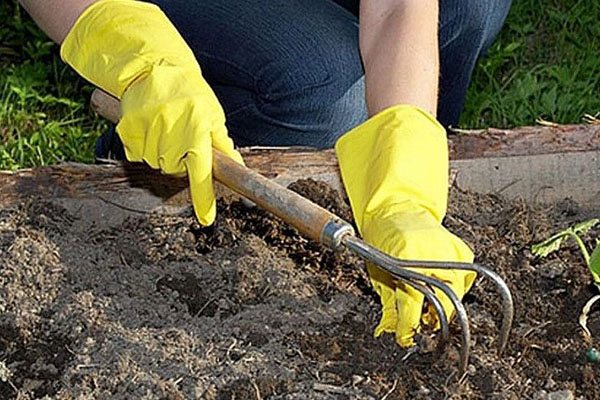

The principle of planting Incarvillea in open ground and caring for it is quite simple. In early spring, the preserved tubers are planted in pots of humus. In this case, you should not close the root collar. By the time the plant is planted in the open ground, new leaves will appear, due to which the Incarvillea will bloom in mid-June.
Questions and answers
- How to properly store the tubers and rhizomes of Incarvillea in winter?
The underground part is dug out of the ground. The tubers are thoroughly washed and then pickled with a fungicide solution. The rhizomes are dried for several days and placed in a box filled with peat. It is necessary to store the tubers at a temperature not lower than zero degrees. The fruit storage compartment in the refrigerator or cellar is best.
- What to do to make the flowers of Incarvillea cut for a bouquet stand as long as possible?
You need to know that, despite the beauty of flowers, incarvillea, after cutting, it will stand in a vase for no more than 1-2 days. Therefore, this type of flowers is not used in bouquet arrangements.
Incarvillea Delaway Purple Bell
A rare, but already gaining popularity in Russia variety, it is distinguished by a rich pink-lilac color of large tubular flowers with a yellow throat. The diameter of the limb reaches 6 cm.The height of the bush is 40-60 cm, the length of the leaves is 30 cm.
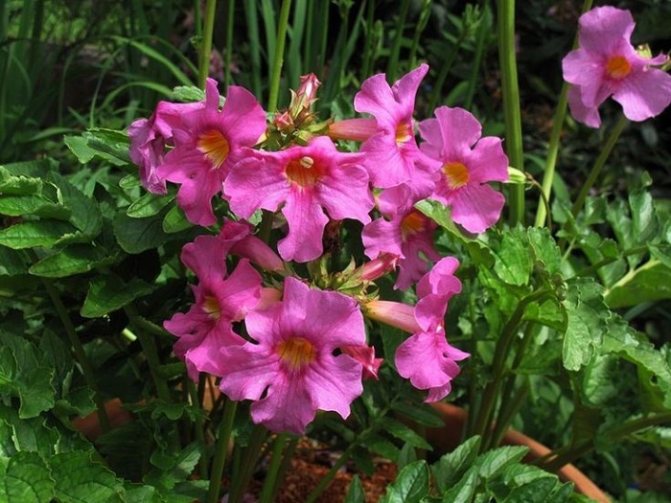

Incarvillea Delaway Purple Bell
In the Middle lane, it can winter without digging, under good cover. Flowers are used for cutting.
Landing rules
Self-collected seeds of Incarvillea must be subjected to preliminary stratification by placing the seed material in an airtight package and keeping it in the refrigerator throughout the winter period. Sowing is carried out in March. The seeds need to be sown in seedling boxes and installed in the greenhouse. You can also do direct sowing of seeds in open ground in the last decade of April. The sowing depth is about one centimeter.
When growing Incarvillea in greenhouse conditions, mass shoots appear in a week. The seedling method of growing involves diving seedlings at the stage of the appearance of the first true leaf. It is necessary to plant ready-made seedlings of an ornamental culture in the ground with a deepening to the cotyledons, after the threat of planting damage by recurrent spring frosts has passed. It is important to remember that the survival rates of Incarvillea seedlings are very low, therefore, in the conditions of home gardening, preference is given to direct sowing in open ground.
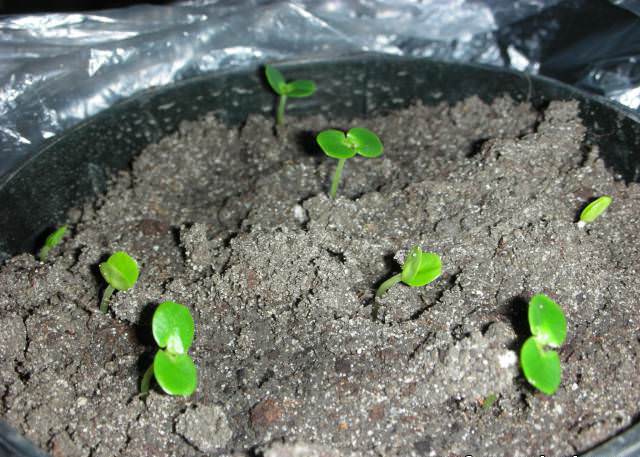

Conditions that suit incarville
Delightful Incarvillea is able to adapt well to any garden area within bright locations. Bright sun or diffused light, light partial shade or unstable lighting are perfect for her. Over time, Incarvillea becomes more and more robust, better tolerates unexpected changes, including stronger shading.
The soil for this plant needs to be selected more carefully. Incarvilles prefer sandy loam soils and bloom well only on fertile soil. Pay attention to drainage: the soil should be light, water and air permeable.
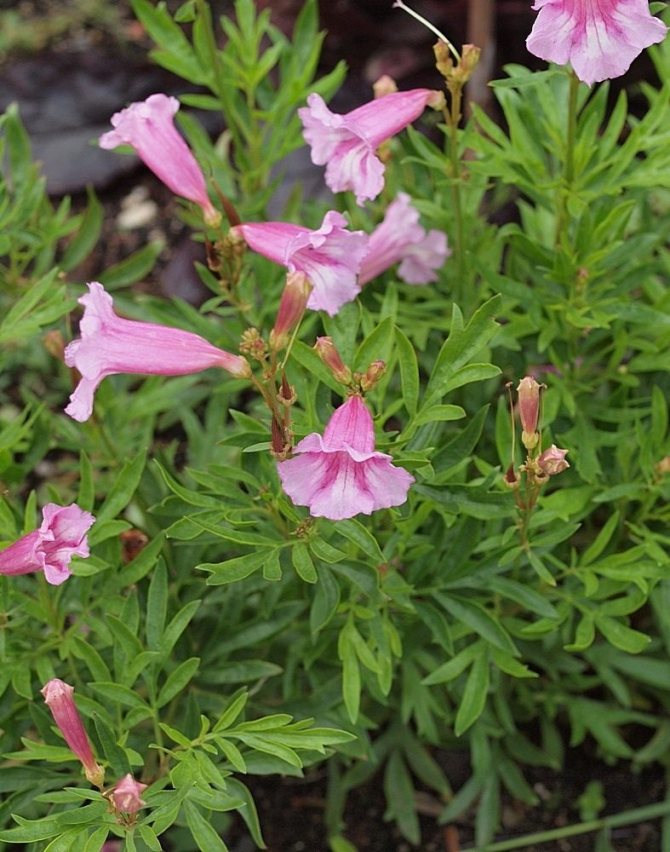

Chinese Incarvillea (Incarvillea sinensis). <>
Transfer
Incarvillea Delaway specimens wintering in the ground grow well and form a voluminous bush. But over time, the flowers become smaller, and the plant itself begins to wither, although the care has not changed. This means that it is time for the Incarvillea to transplant.
In this case, the bush is completely dug out, the aboveground part is cut off, the root cones are washed and examined. Those affected by diseases and pests are discarded, the sucking processes are shortened, they are divided, dried for several hours or days, and planted in a new place. Sprinkle the slices with crushed charcoal.
Transplanted Incarvillea Delaway in early autumn, at least once every 5 years. In the spring in the south, the heat can quickly set in, and the injured delenks will not take root well.
Better yet, dig up the Incarvillea before freezing, and store it in a cellar or basement until spring.
Bloom
Physalis decorative or edible - grown from seeds
The period of plant budding falls on the last month of May. The tops of the stems are literally dotted with buds, which at first look twisted and do not at all resemble the appearance of future flowers.
Every day, the shape of the ovary changes, gradually transforming into funnel-shaped flowers, which can be colored in:
- coral;
- purple;
- pale pink shades.
The diameter of the flowers reaches 55-60 mm.
Flowering occurs in early summer. In the absence of normal lighting, the bases of the flowers, resembling gramophones, are painted in a pale yellow tone. Under normal conditions, the shade of the bases is more saturated. You can admire the flowering of Incarvillea for two months. Gradually, instead of flowers, fruits with winged seeds are formed on the herbaceous crop.
Wintering
Without problems, under a light cover of straw or fallen leaves of fruit trees, Incarville Delaway winters in the frost-hardiness zone 6. In the fifth, you already need to build something more solid. For example, cover a thick layer of mulch with agrofibre or spruce branches. Or dig up an Incarvillea for the winter. Even if a culture survived one winter satisfactorily, there is no guarantee that it will not die the next.
In zone 4, there are no options - you need to dig out the root cones of the Incarvillea before the first frost, dry them in a greenhouse or in a cool, ventilated room. You can store them in the cellar, basement, vegetable compartment of the refrigerator, by placing them in a box or box with sand.
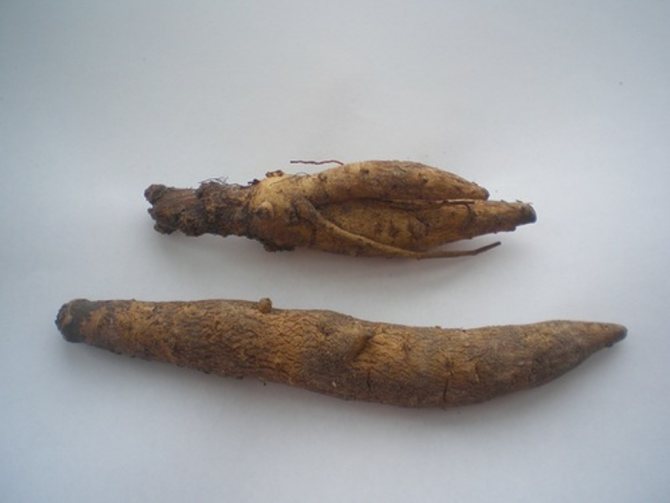

Incarvillea root cones
Top dressing
It all depends on what type of soil is on your site. If you are sure that it has good fertility, then you can use the most common universal fertilizers to improve its quality.
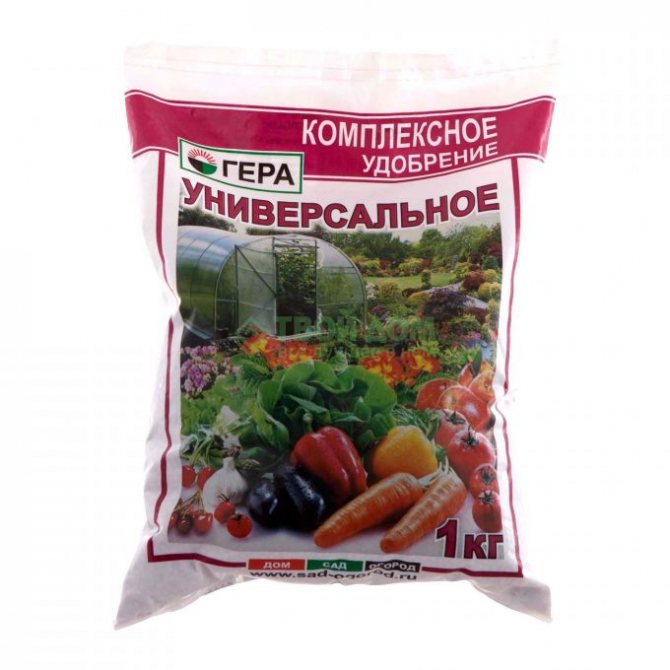

If you see that the plants grow slowly and they are not very strong, then you need to fertilize the soil with humus and specially selected fertilizers several times a month, which saturate it with useful substances. However, do not overdo it with these procedures, perhaps this will improve the land, but it will also negatively affect the plant's resistance in winter.
The first feeding is usually done when leaves begin to actively grow on the bushes. The next one already during the formation of inflorescences. Remember that in mid-August, any feeding should be stopped so that the plant can more easily withstand the low temperature.
Incarvillea, photo and role in landscape design
Incarvillea is a versatile garden dweller that will not get lost in group beds and will look great in a single planting. The plant looks flawless on rocky rock gardens or just in flowerpots near the house. Therefore, wherever you planted Incarvillea, it will be in place everywhere.
Site selection and preparation
Fertile, well-drained, loose soil is suitable for Incarvillea. It does not tolerate waterlogging (root cones rot) and dense soils. If necessary, before planting, you can arrange drainage and prepare a substrate from sand, fertile soil and humus.
In the south of Incarville, Delaway prefers to grow in light shade, such as under the shade of trees or shrubs with an openwork crown. Most of Russia, Ukraine and Belarus are not distinguished by excessive sun activity in summer, so the culture is placed in an open, sunny place.
If the owners are going to plant Incarvillea in a solid mass, the soil is dug up onto a full bayonet of a shovel in at least 2 weeks. At the same time, all the roots of the weeds are removed, but small pebbles can be left. If necessary, sand, humus or fully matured compost is added for digging.
Delaway Incarvillea can be grown as a container crop in high volume plastic or unglazed clay pots. But the plant will have to pay much more attention than in the ground.
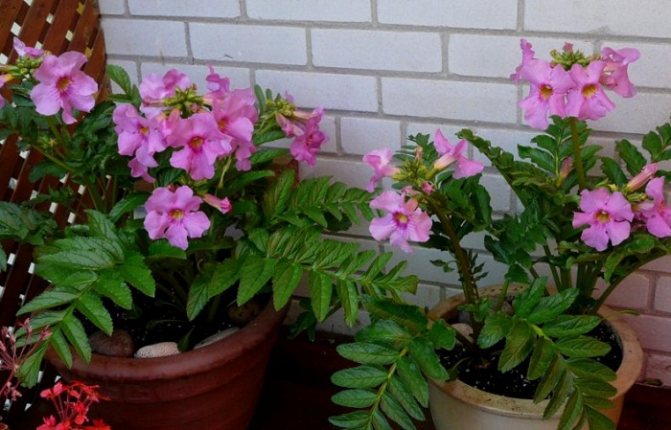

Delaway Incarvillea can be grown in plastic or unglazed clay pots
Wonderful Flower's Outer Robe
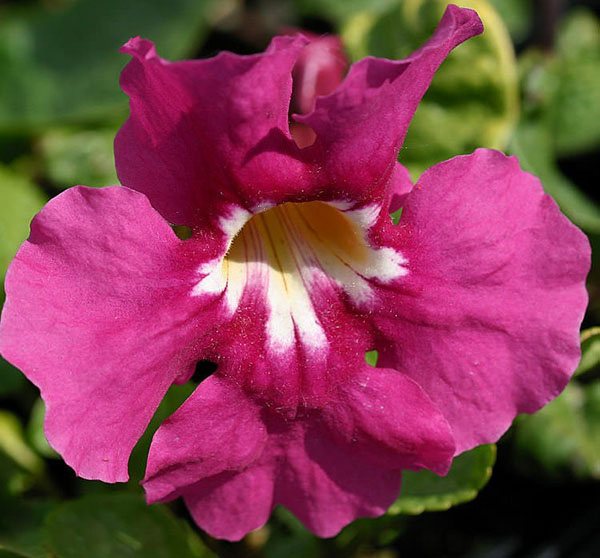

When you enter the garden and see delicate flowers under your feet, you involuntarily want to bend over to touch them by the petals. Such feelings are caused by Incarvillea during its flowering.
The plant can grow from 20 centimeters to 150 centimeters. Its shoots are smooth, decorated with a delicate edging, simple or branched. On their tops, original paniculate inflorescences are formed. Each flower of Incarvillea consists of 5 tubular petals, the diameter of which reaches 6 cm.The color is:
- white;
- deep pink;
- red;
- yellow.
In shape, the bud is similar to gloxinia, which is why some color lovers call Incarvillea this way. The first bloom falls in June. It often lasts a month and a half. It all depends on the variety. The second wave of bud opening is in August, although not so lush.A careful study of the photo of Incarvillea helps to clearly imagine this natural masterpiece.
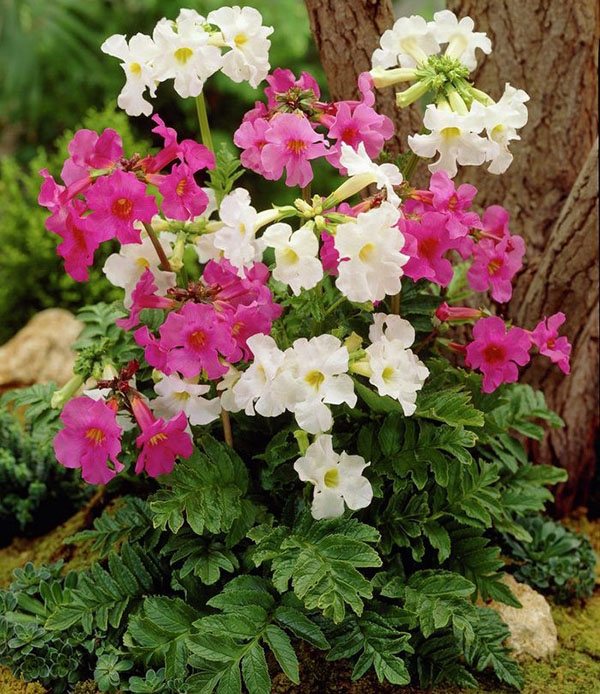

During this period, pods appear from the inflorescences. When they ripen and crack, large gray seeds fall to the ground. Their germination capacity lasts up to 4 years. The sheet plate has a corrugated surface. It reaches 30 cm in length. The color is dark green.
The rhizome of the garden beauty is tuberous, slightly branched. It has an elongated cylindrical shape, outwardly resembles dahlia plots. These features should be considered when growing and caring for Incarvillea.
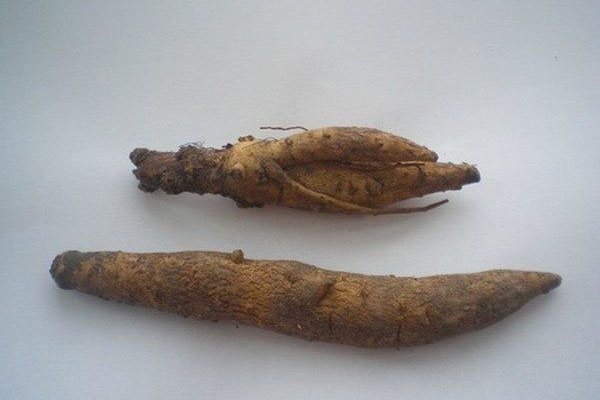

The plant is used to decorate rocky areas of the garden, in flower beds and in rock gardens. For its bright outfit, the flower is sometimes called the front garden "orchid". It looks original in bouquets, although it can be stored in a cut for only 2 days.

